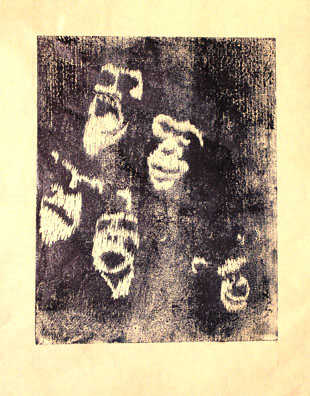Chimpanzee Faces
Woodcut Monoprint

An example of a woodcut print. That is, the image is a print where the printing surface was cut from a wood block. Woodcuts, we need not point out (although we are), are probably the oldest method for reproducing artwork. It is at least thousands of years old, originating we believe, in China, although Japan is probably more famous for this particular type of art.
Not only is this a woodcut print, it is a woodcut monoprint. That is, there is a basic pattern cut into wood (the white chimpanzee faces) but the inking and printing is done in a unique way. In this case the block was inked fairly heavily and different amounts of pressure used in making - "pulling" is the word used by the cognoscenti - the print.
A nice thing about monoprints is (that sounds like bad grammar but it isn't) the actual cutting is less onerous than if you want to make a detailed classic woodblock. For instance, here the only cutting was the faces of the chimps (followed by a bit of wirebrushing to bring out some of the grain). If the block was inked and printed with constant pressure (such as using a press), then you'd just have the white faces in a black uniform background.
Instead the printing of this block was simply hand pressure (although some of the alternate "pulls" were with using a sanded rice spoon). The paper itself - as is common on hand, spoon, or baren (a Japanese tool for making prints) - is fairly thin. In this case it was not rice paper, but mulberry.
Printmaking does involve some experimentation and sometimes the proofs are made using newsprint. Newsprint, of course is very cheap, but as anyone who remembers newspapers knows, it tends to degrade quickly and in a year or two you have a crumbling yellow print. Also print making paper isn't the cheapest paper, but you can't have everything.
But the true connoisseur should never confuse a monoprint with a monotype. A monoprint is, like this print, based on a specific design. This, as we said, was a woodcut but any print plate - metal, wood, whatever - with a specific design can be a monoprint as long was you ink it or print it in a way that makes a one-of-a-kind print. But a monotype is a print made by making a design or drawing in ink on a blank printing plate and making the print. When you first hear about monotypes, you wonder what the heck's the point? Why not just draw the darn picture rather than draw it and then print it?
Well, there's lots of of reason. You can make monotypes by all sorts of techniques that will produce designs that would be extremely difficult to make by painting or drawing but are quick using printing. For instance, if you take something like gauze or cheesecloth and pull it apart of separate the fibres, you can ink it and make a very intricate print that can serve on its own or be a starting place for more printing. You can even combine the monotyping with painting or drawing. This was, in fact, one technique used by Edgar Degas who would sometimes would make a monotype - often a trace monotype - as a starting point for his paintings or pastels.